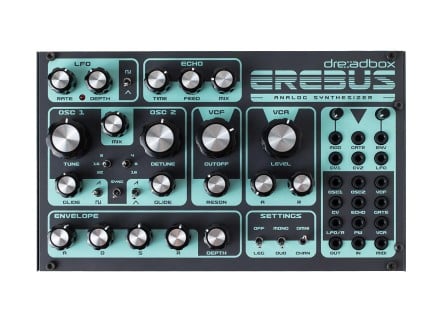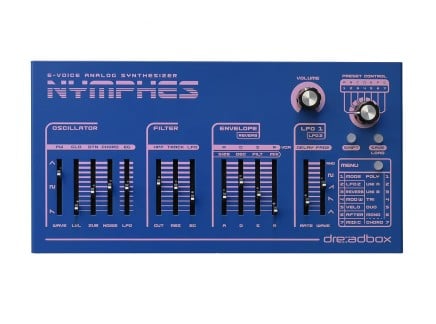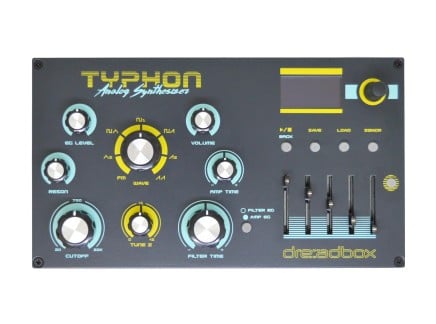Since its founding in 2012, the Athens, Greece-based Dreadbox has carved out a unique space for itself in the crowded scene of boutique synth manufacturers. From humble DIY beginnings, the company has traveled steadily along the road of success, releasing a plethora of products from guitar pedals, to Eurorack modules, to semi-modular powerhouses. Dreadbox’s releases—all sporting bold graphics and characterful design—are consistently alluring, intuitive, and high-quality. Much of this is due to the symbiotic relationship of company co-founders Yiannis Diakoumakos and Dimitra Manthou. Theirs is a special kind of collaboration, one that extends beyond their business together and into almost every other aspect of their life. The unique and distinctive vibe of Dreadbox is a testament to their partnership. I had a chance to chat with Yiannis and Dimitra this autumn and was granted a window into their relationship, their process, and their attitudes toward design, collaboration, and the challenges of running a successful synth business.
An Interview with Dreadbox

Sam Chittenden Why did you start Dreadbox?
Yiannis Diakoumakos: Dreadbox was started so that we could get gear. Me and Dimitra used to be musicians, but because of our financial status, we were not able to buy gear. At that time, buying just a Rat pedal costing 70 euros was a big expense for us, so Dimitra simply suggested that we should make our own.
SC: Necessity is the mother of invention. Were you into synths when you started building stuff?
YD: I love synths, but I have not deeply used many of them, [and have] probably owned less than fifteen in total, although on expos I get to play with all of them. I am (or was) a bass player who just happened to see a video of The Cure performing live (Cold in Paris in '82) on YouTube and just wanted to do what Simon did. I want to consider my mind clear of inspirations and “idols,” but I am pretty sure that this is not the case.
SC: What were you doing for work before you started the company?
YD: I was a typographer at a printing press and Dimitra was—and still is—a graphic designer.
SC: What did your typography job consist of ? Were you designing fonts?
YD: I was working on offset printing machines. It’s a boring factory type job that is also dangerous and causes long-term health problems. Very fun! In the Greek educational system, you do not really choose what you study. You can actually set a choice, but it’s usually very hard to get to it, so you end up in a university you queued “just in case,” unless you have money. I wanted to study mathematics, but my high school degree was not enough to get me there.
SC: Dimitra, do you have formal art or design training?
Dimitra Manthou: I have studied in an Art & Design college in Athens and worked in a few creative companies. Before Dreadbox I was mostly working on printing material, and I had the chance to work on many fields of graphics such as web design, newspaper, photo retouching, product catalogs, logotype, interior graphic design for shops, etc. At the same time I was also a freelance designer, where I was mostly working on music stuff, posters, and album covers.

SC: Yiannis, you were working for a printer and Dimitra was a graphic designer. Did your paths cross in those jobs? Is that how you met each other?
YD: I used to play the bass in a band, and we needed someone to play some violin. The band leader knew Dimitra and got her to join us.
SC: So you met in the band and out of necessity started making gear and from there started a business together. How was the transition going from musical partners to business partners? Do you still get a chance to play music together?
YD: Well, it’s a question I cannot easily reply to, so I’ll describe [our] relationship. We started as musical partners, then just partners, then business partners, then we got Curtis [our dog] and finally ended up to be parents. She is my best friend, Dreadbox co-owner, and mother of my child. We (almost) never argue and we are happy for each other. Me and Dimitra complete each other, and what I miss to predict she does, and vice versa. Not sure what more one can ask from life. Oh, and there is really no free time to play actual music anymore.
SC: I can see why. Do you miss being in a band together?
YD: In a way we are still a band, we just do not play music, so I cannot say I miss that part. Gigs were fun, but I can’t say I miss them. I’d love to work on something though, and perform. In that perspective, I would like to, but I do not miss it.
SC: Dreadbox seems to have grown quickly since it was started. How long had you been in business before you hired someone to help out?
YD: Only a few weeks. At least, that is when I got into the commercial part. Alex [Karapanos] has been working with us since we started. He is now our Production Manager.
SC: That’s pretty quick. So you were both coming at this new business from a musician/DIY background, how did you learn about manufacturing? What was the learning curve like?
YD: I learned everything the hard way—by failing. Before I started Dreadbox I had changed more than ten to fifteen different jobs—mostly because I was getting bored very fast at the same place. For example, I used to work at Dominos, at a gas station, at a supermarket, as a seasonal waiter on islands, and many more, but in every new place I would go I learned something new. At that time I did not think of it [that way], but later on [with] Dreadbox, I really managed to evaluate how important that was.
SC: Many people start out with DIY and then stay at DIY forever. What did it take to get to the point where you decided to make a go of it and start your own company?
YD: Well, there are a number of things that got me there: I needed a job to survive, I was motivated by those around me, I am adventurous, and I hate being stable. I always want to improve what I do, on any level.
SC: What was that learning process like?
YD: There were a lot of “aha!” moments. I am still learning things. It's very difficult for one to see his own progress, but sometimes I look at old schematics and they seem like something very amateur to me.
SC: I know that you assemble everything by hand, is there a reason for that?
YD: We have to get the PCBs preassembled with their SMD parts, but the rest of the work is done here. This has three levels of importance: One, it’s much cheaper—mostly because we save a lot on imports and shipping costs—thus the end product is cheaper to buy and we can be competitive. Two, you have complete control over your production. Three, you can offer work to a country with [high] unemployed rates.
SC: So you started out DIYing gear for yourself, then launched Dreadbox. What was the time frame there? How long did it take you to feel confident in your engineering abilities?
YD: I am still not confident, but if you mean at what point I decided that I can throw a schematic into the market, I think it took me three years of really hard reading and experimenting.
[Above: a taste of Dreadbox's design sensibilities, via the Hypnosis, Murmux 2, Hades, and Erebus V3]
SC: Dimitra, you do all of the interface design and the graphics for Dreadbox’s products and they all have a very unique and identifiable aesthetic to them. Are there any specific influences in the way you design Dreadbox’s interfaces? Was there a big learning curve for you when you started designing synth interfaces?
DM: I always wanted a synth that will be straightforward to me! The truth is that it did not take me very long to establish my aesthetic on designing interfaces. When the development team has an idea on a synth or effect, my work starts and I feel happy about it. The name of the device is the first wave of inspiration for the color and layout and then the electronic device itself. Every period of my life I [get] stuck in specific colour palettes, which I pretty much end up using when a new product is being born [during the same] period. This past year I have been into neon pop colour schemes. I had no experience in product design before working on pedals and synths and I find that this helped me to give a distinctive touch to the devices I design, but of course the first synths that I designed (Murmux series) are a bit primitive to my eyes.
SC: Are there some designers or artists you are particularly inspired by?
DM: Aleksandr Rodchenko, Herbert Bayer and Laszlo Moholy-Nagy. Of the contemporary ones, I appreciate the work of Stefan Sagmeister and Kate Moross, but I am mostly inspired by little things that I stumble upon now and then, or things/eras that I reminisce about. Lately I design by nostalgia.
SC: Is that nostalgia inspired from your childhood? Or is it inspiration from a more distant past?
DM: I design with a mood of being nostalgic of my past. I was born in the 80s, so very often I recall ads, shows, and products that now mean so much for me from that period of time. When I am designing a layout of a Dreadbox device my main concern is that it be clear and understandable. I want when someone has in their hands a Dreadbox device, to instantly understand its controls and features. In order for me to achieve this, I design clean and minimal layouts. The challenge when designing for Dreadbox is that I have to think differently each time a new device is coming to my hands. I feel it is alive and it needs to have a distinguished form and identity. I fully enjoy positioning the hardware controllers (potentiometers, sliders, etc.) on a panel. It is a really hard job, but when I see the final result, I feel satisfied and get inspired for the next phase.
SC: That striking visual aesthetic is echoed in the naming of your standalone products. They all have these distinct names, deities of Greek mythology. Is that mythology heavily rooted in daily Greek life or is that more due to a personal interest in it?
YD: I find history in general fascinating and actually very educational if you pay attention to it. Of course here it’s mythology that we are talking about, but we have to remember that people make myths based on true facts that they cannot otherwise explain, or understand. I think that mythology in Greece tends to disappear from everyday life, as globalisation and information takes its place instead. Kids no longer find an ancient deity cool—which is perfectly normal—but things like Marvel and other TV stars take their place.
SC: It’s an interesting juxtaposition between these modern synths you make and the ancient legends that they are named for. Everything old becomes cool again, eventually. Maybe this isn't something you consciously think of, but by having a panel aesthetic/interface design and the functional engineering collaborating from the outset— do you feel that it makes the process go faster?>>>>
YD: You cannot imagine how much faster that goes. If no digital programming is involved, me and Dimitra can create a product out of nothing in just ten to fifteen days.
SC: Does that approach send a product in a different direction from its initial idea, or do you find that it leads to end products that are more tightly related to the original concept?
YD: The product ends up how it originally started, but on steroids. As we are working back to back, while Dimitra for example is making the panel, she might say, “Yiannis we have a gap here on the filter that needs a switch in order to be complete.” So I just have to figure out something that the switch could do.
SC: Definitely a different way of working. What does a typical development timeline look like for a Dreadbox product?
YD: Depends on the kind of product. Sometimes it only takes two to three weeks (our first version of Erebus for example), but other things, like Typhon, that need to have more than just me and Dimitra involved, can take up to a year.
SC: What is that process like?
YD: Usually I think of a product—although lately I discuss it with my team—and describe it to Dimitra, where she will make a quick illustration of its panel, and we redesign it until we are happy with the layout. Meanwhile, I have some schematic drawings ready, and I get the panel layout to make a prototype PCB. We make sure its analog parts work, and then we hand it over to our programmers to make the firmware, if needed. While in the process of firmware programming, we make small improvements and fix various details.

SC: Are there any specific challenges to running a synth company in Greece?
YD: Extremely high taxes, no real help from the government, but instead mostly obstacles (even though its an export product) and also—hard to find skilled people.
SC: What kind of obstacles does the government present?
YD: Hard to explain that part in depth, but most common are almost 30% taxes, ridiculous high custom fees, no actual support funds, zero education [means that it is] hard to find trained staff and getting foreigners to work here consists of a long bureaucracy procedure, very bad infrastructure (it's almost impossible to find a good workspace for rent)...want more?
SC: I get the idea! Overall, what is the synth scene like in Greece? In Athens?
YD: I would not say there is an actual synth scene, although there are some really good synth artists, but a lot of people tend to start DIYing (modular and synths), and I think this will eventually improve that field.
SC: Why do you think there isn’t much of a scene? I assumed that the country of Vangelis would be full of synth heads!
YD: Yes, there are some people that play synths, but not an actual scene. Most people tend to play the guitar, and lately they all want to become trap artists.
SC: This is probably a silly question given that you two have a business, a dog, and a child together, but pre-COVID did you get any opportunities to go out and enjoy music as an audience member?
YD: Not really, as I am agoraphobic. Not in a very developed stage I would say, as I can be around many people, I just do not feel nice at all, resulting in not being able to have fun at a gig. I think it has to do with my dyslexia issue, as I have issues talking comfortably to people I do not know well.
SC: How has that shaped Dreadbox or your approach to things?
YD: Well, dyslexia has not affected my work with Dreadbox a lot, but it just leads to mistakes that otherwise I would have not performed. Also Dimitra must check everything I type or write, otherwise it's guaranteed that it would not make much sense sometimes. My agoraphobia is not that severe, I just cannot be in very crowded places as I feel very uncomfortable—not that I cannot survive there. I also avoid the use of public transportation. I think it only affects [my work with] Dreadbox to the point where I avoid meeting people at big expos.
SC: Dreadbox has its roots in your partnership and that ethos of collaboration has extended with a couple of your more recent releases: The Medusa with Polyend and the Typhon with Sinevibes. How did those collaborations come about? Were you approached by them? Did Dreadbox reach out and propose collaborations or did they come about more organically?
YD: We had some people and companies approaching us in the past, but in general we prefer to choose who we work with. Both Polyend and Sinevibes are great companies that can do something we don’t, and vice versa. Collaborating can never really hurt anyone, as long as they both respect each other. You can only learn from it.
Thanks to Waveform Magazine
Waveform is a quarterly print magazine about sound synthesis and those who inhabit that world. Check out Waveform on our site, or head to their own website to subscribe, grab some swag, DIY projects, and more!
















